Commons? Urban space? These days? With these election prognoses?
But, to more hopeful things. This afternoon a packed seminar room at Kiasma museum of contemporary art heard three excellent presentations and discussion that exploded many a myth about the benefits of cultural projects like the Guggenheim Foundation’s/franchise’s efforts to woo Helsinki’s leadership and public to let it come here and play. While we, of course, pay.
Michael Sorkin, Andrew Ross, Miguel Robles-Duràn and Mabel O. Wilson had come from New York invited by Checkpoint Helsinki to share with us their experiences and analyses. As they spoke, the idea of a Guggenheim museum in Helsinki benefiting anyone in Helsinki started to sound even crazier than it had previously. Such a project would draw us into an international urban renewal circus in which there are no winners, only exhausted competitors. I’d note that the madness of “titanium-clad-starship-cruiser-museums” (I think that was Andrew Ross) as serious municipal endeavours, hasn’t yet – thankfully – quite engulfed us because we are a little behind in so many policy fashions. It also need not cheapen our city or diminish its charms if, as Juhani Pallasmaa put it, we (or our city managers, whoever they are) learn to be a bit less naive than hitherto.
Alas, Helsinki’s public is not known for its critical sensibilities, at least not when it comes to the kind of free-market, free-world, free-everything rhetoric peddled as standard across (still) wealthy European cities (not to mention elsewhere).
Opening Helsinki up to the Guggenheim would mean that our lives, our streets and our most creative impulses would mingle with the evils [sic] of the global construction industry and its truly appalling discounting of human lives. As we heard today, the Guggenheim is among several institutions blithely ignoring yet massively benefiting from the subhuman conditions in which construction workers (and others) in the United Arab Emirates have to live.
So, no longer is one’s ire just (?) a result of confusing cities with theme parks. It’s about just how entangled one wants to become in the global intensification of a totally crazy and utopian set of values and aspirations that passes for mainstream and wreaks so much destruction, throughout the production chain. And yet which, in shy little Finland, only a few dare question.
And so it was with sadness that I was reminded of how earlier commentators on Helsinki’s urban changes have identified a problem here that goes deeper than arguments over costs and benefits.
In a short film by Marja Heikkilä & Martti Saarikivi about the old picture house, Kino Palatsi (1911-1965), the narrator notes “the city may not be that old, but it is full of memories. People shape their environment and the environment shapes them”.
I was born after Kino Palatsi was torn down, but vicariously its memory has shaped a small part of my life too.
Later in the film, he goes on: “a last-minute public debate failed to yield fruit before the hasty implementation of a demolition order meant that the sounds  of debate were drowned out by the noise of machinery. Seeking explanations for this frenzy of tearing down buildings, one usually hears arguments about the economics. The reason lies deeper, however. Our towns are young and most of their inhabitants recent arrivals. That is why we lack urban tradition, and why the majority of people do not feel the kind love for their hometowns that would be expressed by respecting tradition (heritage).”*
of debate were drowned out by the noise of machinery. Seeking explanations for this frenzy of tearing down buildings, one usually hears arguments about the economics. The reason lies deeper, however. Our towns are young and most of their inhabitants recent arrivals. That is why we lack urban tradition, and why the majority of people do not feel the kind love for their hometowns that would be expressed by respecting tradition (heritage).”*
Well, I don’t buy that, quite. I don’t believe people are that uncaring, and besides, that documentary was shot in 1968.
Helsinki has grown a lot since then and urbanization around the world keeps accelerating. The throughput of stuff and life and rural land required to service all this urban change has taken on such unfathomable dimensions that er, words fail.
So what I’m getting at is that in a way we are all – at least anyone for instance who might stumble on this blog post – living urban lives. And whether it’s in Helsinki or Hong Kong or Hamburg, surely the chances of good urban futures are better without the cheapening and democracy-weakening antics of global brands and global privatisers of all kinds.
Tomorrow, when we know who will represent the people of Finland for the next four years, there will also be excitement as the public gets to see the results of the Next Helsinki Competition tomorrow.
(And I don’t think the fear and parochialism I read into the election results is unrelated to the embrace of these shiny and placeless vehicles of spectacle captured to serve new urban, though not always civilized, ideals).
http://www.nexthelsinki.org/#about
* Viime hetkessä herännyt julkinen keskustelu ei ehtinyt vielä kantaa hedelmää kun jo purkupäätöksen nopea toimeenpano hukutti virinneen keskustelun kiviporien meluun. Kysyttäessä syytä … purkuvimmaan viitataan yleensä taloustekijöihin. Syy on kuitenkin syvemmällä. Kaupunkimme ovat nuoria ja suurin osa asukkaista on tulokkaita. Siksi meillä ei ole kaupunkitraditioita eikä asukkaiden enemmistö tunne kotipaikkarakkautta, mikä kuvastuisi perinteiden kunnioittamisessa.

